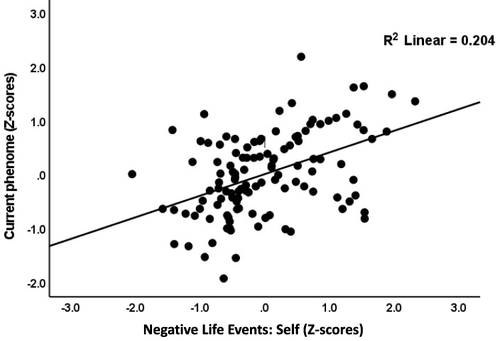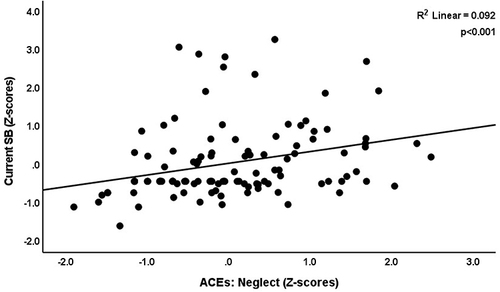Figures & data
Table 1 Results of Principal Component (PC) Analyses and Construction of Adverse Childhood Experiences (ACEs) and Negative Life Event (NLE) Principal Components (PCs)
Table 2 Demographic and Clinical Data of Patients with Major Depression (MDD) with High versus Low Adverse Childhood Experiences (ACEs), and Healthy Controls (HC)
Table 3 Clinical Features of Patients with Major Depression (MDD) with High versus Low Adverse Childhood Experiences (ACEs) and Healthy Controls (HC)
Table 4 Correlation Matrix Between Adverse Childhood Experiences (ACEs) and Negative Life Events (NLEs) and Other Clinical Features of Depression
Table 5 Results of Multiple Regression Analyses with Current Phenome, Suicidal Behaviors and Neurocognition as Dependent Variables and Adverse Childhood Experiences (ACEs) and Negative Life Events (NLEs) as Input Variables
Figure 1 Partial regression of the current phenome score on principal component of negative life events in self-subcategories (after controlling for the effects of age, sex, number of education years, and current smoking).

Figure 2 Partial regression of current suicide behaviors (SB) on principal component of adverse childhood experiences in neglect-subcategories (after controlling for the effects of age, sex, number of education years, and current smoking).

Figure 3 Results of PLS analysis. The significant pathways are presented, including the path coefficients (along with their exact p values) of the inner model and the loadings (with p values) of the outer model. One factor was extracted from the subcategories in adverse childhood experiences (ACEs), such as abuse, neglect, and family dysfunction. Sexual abuse was included as a single indicator (denoted as +). Negative life events (NLEs), the depression phenome, and cognition were entered as latent vectors extracted from their manifestations. Figures in blue circles indicate explained variances. Shown are path coefficients (with p values) and factor loadings (with p values). “Abuse” reflects the emotional and physical abuse subcategories of ACEs; “Neglect” reflects the emotional and physical neglect subcategories of ACEs; “Family” reflects household dysfunction, including domestic violence, mental illness in the household, and parental divorce subcategories of ACEs; “Self” reflects NLEs self-subcategories, such as hassles in health issues and insufficient money; “Academic” reflects NLEs academic-subcategories, such as hassles in academic course, course interest, and limitation in academic ability; “Relationship” reflects NLEs relationship-subcategories, such as hassles with friends, parents, relatives, and other students.

Data Sharing Statement
The raw data supporting the conclusions of this article will be made available by the authors, without undue reservation.
